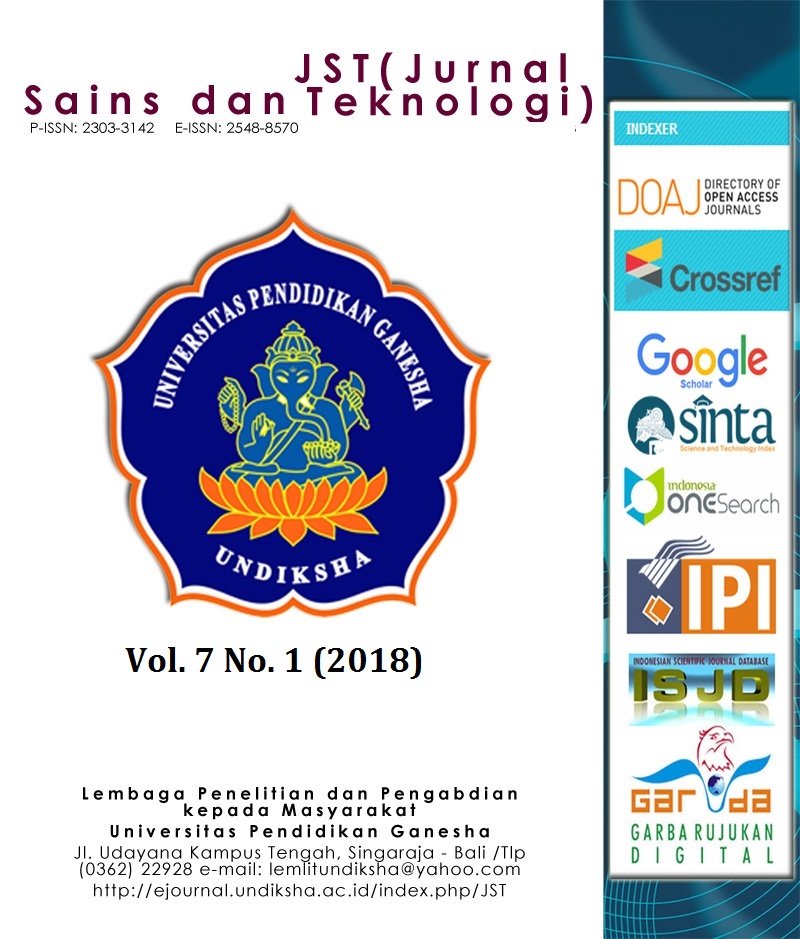Perancangan Hardware Sistem Monitoring Portabel Untuk Monitoring Arus dan Tegangan Listrik Menggunakan Raspberry Pi
DOI:
https://doi.org/10.23887/jstundiksha.v7i1.13003Keywords:
hardware, monitoring, sensor, arus, tegangan, webAbstract
Sistem monitoring mencakup pengumpulan, pelaporan, dan tindakan atas informasi suatu proses yang sedang berlangsung di suatu ruangan. Salah satu hal yang dapat dimonitoring pada ruangan adalah tingkat penggunaan listrik. Pada penelitian ini, dilakukan perancangan hardware sistem monitoring portabel yang dapat memonitoring arus dan tegangan listrik AC. Desain hardware menggunakan prosessor Raspberry Pi untuk mengolah hasil pembacaan 4 buah sensor arus YHDC tipe SCT-013-000 dan sensor tegangan AC. Hardware dapat diakses melalui antarmuka konfigurasi berbasis web yang menampilkan konektivitas jaringan dan nilai dari sensor-sensor. Hasil pengujian sensor arus pada saluran listrik 3 fase RSTN dan pengujian sensor tegangan didapatkan bahwa LCD pada hardware dan antarmuka konfigurasi berbasis web telah berhasil menampilkan nilai pembacaan sensor-sensor. Hardware juga telah berhasil terhubung ke jaringan wireless “RUANGAN01”pada alamat IP 192.168.8.107. Keseluruhan fungsionalitas antarmuka konfigurasi hardware berbasis web seperti login, koneksi perangkat, konfigurasi “on” sensor, reboot, shutdown dan reset juga telah berfungsi dengan baik dan sesuai dengan rancangan.References
Mercy Corps. (2005). Design, Monitoring and Evaluation Guidebook, (August).
Prabowo, I. P. H., Nugroho, S., & Utomo, D. (2014). Penggunaan Raspberry Pi Sebagai Web Server Pada Rumah Untuk Sistem Pengendali Lampu Jarak Jauh Dan Pemantau Suhu. Techné Jurnal Ilmiah Elektroteknika, 13(1), 111–124.
Permana, D. T. (2014). Sistem Monitoring Menggunakan Mini PC Raspberry Pi. Teknik Komputer Unikom – Komputika, 3(1), 1–6.
Rakhman, E., Candrasyah, F., & Sutera, F. D. (2014). Raspberry Pi–Mikrokontroler Mungil yang Serba Bisa. Yogyakarta: Andi Offset.
Dinata, I., & Sunanda, W. (2015). Implementasi Wireless Monitoring Energi Listrik Berbasis Web Database. Jurnal Nasional Teknik Elektro, 4(1), 83–88.
Santoso, B., Mustika, I. W., & Kusumawardani, S. S. (2014). Pemodelan Monitoring Pemakaian Dan Penghematan Energi Listrik Dengan Teknologi Jaringan Sensor Nirkabel. Seminar Nasional Teknologi Informasi Dan Komunikasi, 2014(Sentika), 529–536.
Adafruit. (2017). Introducing the Raspberry Pi 2 - Model B. https://learn.adafruit. com/introducing-the-raspberry-pi-2-model-b?view=all. Diakses tanggal 5 Mei 2017.
Microchip. (2008). 2.7V 4-Channel/8-Channel 10-Bit A/D Converters with SPI Serial Interface, 1–40. Diperoleh dari: https://cdn-shop.adafruit.com/ datasheets/MCP3008.pdf
Beijing YaoHuadechang Electronic Co., L. (2011). SCT013-000 Datasheet.
Electrical4u. (2017). Bridge Rectifiers. https://www.electrical4u.com/bridge-rectifiers/. Diakses tanggal 5 Mei 2017.
JIMB0. (2017). Voltage Dividers. https://learn.sparkfun.com/tutorials/voltage-dividers. Diakses tanggal 5 Mei 2017.
Kumar, M., Singh, S. K., & Dwivedi, R. (2015). A Comparative Study of Black Box Testing and White Box Testing Techniques. International Journal of Advanced Research in Computer Science and Management Studies, 3(10), 32–44.
Downloads
Published
How to Cite
Issue
Section
License
Authors who publish with the Jurnal Sains dan Teknologi (JST) agree to the following terms:
- Authors retain copyright and grant the journal the right of first publication with the work simultaneously licensed under a Creative Commons Attribution License (CC BY-SA 4.0) that allows others to share the work with an acknowledgment of the work's authorship and initial publication in this journal.
- Authors are able to enter into separate, additional contractual arrangements for the non-exclusive distribution of the journal's published version of the work (e.g., post it to an institutional repository or publish it in a book), with an acknowledgment of its initial publication in this journal.
- Authors are permitted and encouraged to post their work online (e.g., in institutional repositories or on their website) prior to and during the submission process, as it can lead to productive exchanges, as well as earlier and greater citation of published work. (See The Effect of Open Access)
















